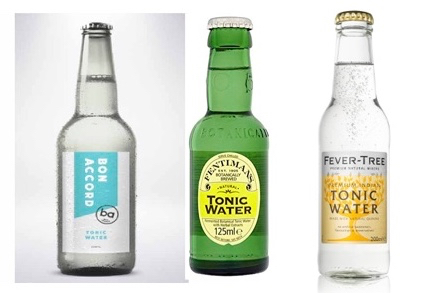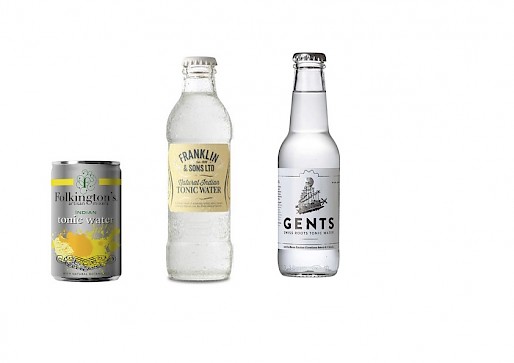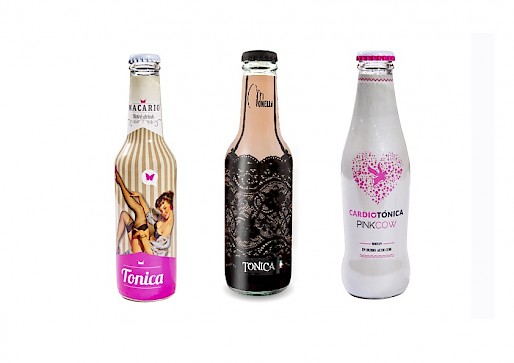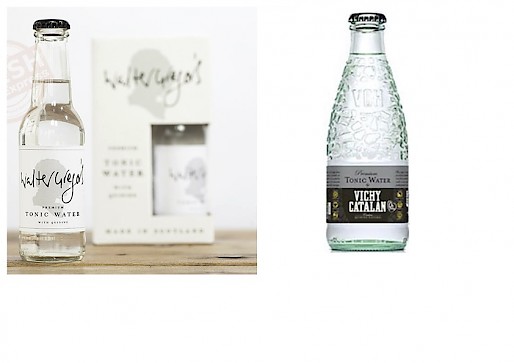Fashions come and go, but timeless classics stick around. This, my gin-soaked friends, is the gin and tonic: the LBD of the bar - understated but chic, lifting the spirit as you pour the gin, gladdening the soul as you splash in tonic. And there it is: let's pause a moment and give tonic a thought. There’s a big world out there so we decided to shake things up a little: a line-up of home-grown and far-flung tonic waters was put to the test by our rigorous tasting panel. Avoiding low calorie and flavoured varities (need you ask), we did a pick-n-mixer of the usual and the unusual - with thanks to The Storehouse near Inverness. Those guys are gin-smart: if you haven't been yet, go.
So, in alphabetical order:

Bon Accord (2016, Arbroath). More than 100 years after the Bon Accord Drinks company was set up, the great-great-grandaughter of the founder has resurrected the brand. Their tonic is lean with simple notes of sweet strawberries with very little bitterness. Our match: The Pinkster, or a fruity gin liqueur such as Gordon Castle Raspberry.
Fentimans (1905, Northumberland). Still a family-owned business after 100 years, all mixers are botanically brewed for seven days. A big noisy friend, this tonic has notes of herbaceous pine up front, then comes the fruit and a touch of bitterness on the tail. It needs a punchy gin that can cut through the mixer and won’t get lost. Our match: Stirling Gin’s basil and nettles will work well with the herb base, or NB Navy Strength would have enough kick.
Fever Tree (2005, London). Experts from Plymouth Gin and luxury food marketing are behind the Saturday Night Fever Tree movement. With light elderflower up front and citrus in body with a dry finish, this tonic is a good all-rounder – but best with traditional juniper-led or lightly citrus gins. Our match: Isle of Harris or Porter’s.

Folkingtons (2011, East Sussex). Named after a tiny hamlet nestled in the South Downs, this is where inspiration struck for the drinks business. The tonic is brightly fizzy with a cream soda flavour; a sweet gin would be a little too much, so we would opt for lightly floral. Our match: Loch Ness (the caramel top notes will work particularly well) or Heather Rose.
Franklins (1886, London). Starting out as a cosy family confectioners brewing home-made ginger beer, this brand is making it big. The tonic is very lemony and very fizzy and would pair nicely with a solid citrus gin, or a juniper-forward profile. Our match: Daffy’s Manor House or Esker.
Gents (2012, Switzerland). Created by a raw material producer at Lake Zürich, this gin contains Swiss beet sugar to balance the quinine and bitter liquorice. It has the sweetness of dandelion and burdock up front, with a tart finish, and is brilliantly suited to the Old Tom style of gins. Our match: Makar Old Tom or Hayman’s Old Tom.

Macario (1950, Italy). The retro design celebrates the beginnings of the company in the 1950s when the Macario family grandmother started her small, home-made production line. The tonic is almost a light lemonade; very soft on the quinine and not particularly dry. This would work well with a slightly sweeter gin or sweetly fruity gin. Our match: Orkney Mikklemas or Filliers Tangerine.
Monelli (2013, Italy). Branding the bottle as a woman wearing black lace reflects tonic as a ‘protagonist of the night - the ideal partner of a thousand cocktails’. Up front there is bitter peaches, then the taste is slightly sweet with a dry aftertaste. This is made to pair with fruity gin liqueurs or a gin with a good balance of juniper and citrus. Our match: Gin Bothy Rhubarb or Shetland Reel.
Pink Cow (2014, Spain). The team behind this 'cardio tonic' claim to have created a new category, the refremixer, which is responsive to innovations in the beverage market. With a strong flavour of sour cherries, and slightly dry finish, the gin needs to balance out the tonic. An aged or malted gin would stand up well. Our match: Firkin or El:gin.

Vichy Catalan (1881, Spain). This tonic is made with Vichy Catalán natural mineral water from the Caldes de Malavella spring. It is really clean, fresh and easy drinking; perhaps a little sweet on the finish. As a very light tonic, this lets the gin breathe and is my favourite. Choose a good gin you don’t want interfered with. Our match: Persie Herby & Aromatic or The Botanist.
Walter Gregor (2015, Aberdeenshire). Named after a local Minister from the 1860s because of his love of plants, it’s no surprise that this is a heavily floral tonic. There are roses up front with an elderflower body and a bitter aftertaste. It would suit a richly floral gin. Our match: Darnley’s View or Lussa.
One last word: there is a second school of thought. My other half claims adding tonic to gin is like adding ketchup to caviar. But we’ll come back to sipping gins another day!
SaveSave
Laziness is having a moment. We use emojis instead of words to say how we feel, ...
Fashions come and go, but timeless classics stick around. This, my gin-soaked ...
Hangover-free gin?! OK, you've piqued my interest; pull up a chair. And here's ...
Latest HMRC figures show 56 new distilleries opened their doors in 2015, ...
Spirit-lovers who are fretting about Absolut's plans to reduce the number of ...
Most of us know that 70% of gin consumed in the UK is made in Scotland. But ...
To access Gin Club Scotland you must be of legal drinking age in your country of residence.